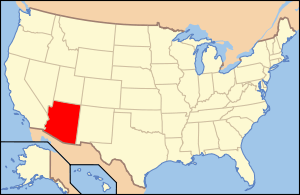Phoenix Union High School
Phoenix Union High School was a high school that formed part of the Phoenix Union High School District in Phoenix, Arizona.
| Phoenix Union High School | |
|---|---|
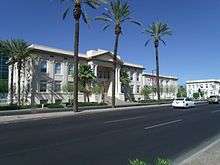 | |
| Address | |
512 East Van Buren Phoenix , Arizona | |
| Information | |
| Type | Public secondary school[1] |
| Established | 1895[2] |
| Status | closed |
| Closed | 1982[2] |
| Grades | 9-12 |
| Enrollment | 1,274 (1982)[3] |
| Color(s) | Red and black[4] |
| Mascot | Coyotes[3] |
Phoenix Union High School Historic District | |
| Area | 18 acres (7.3 ha) |
| Architect | Norman F. Marsh (original 3 buildings) Lescher, Kibby and Mahoney (Liberal Arts Building and the Stadium) Fitzhugh and Byron (designed the Phoenix College, now Unit A) |
| Architectural style | Beaux Arts, Renaissance, Mission/Spanish Revival |
| NRHP reference No. | 82002085[5] |
| Added to NRHP | July 15, 1982 |
Much of the campus was listed on the National Register of Historic Places in 1982 as Phoenix Union High School Historic District.[6]
History
The school was established in 1895, before Arizona's statehood.[7] It was, for many years, the oldest secondary school west of the Mississippi River.[7]
When PUHS first opened, it had four classroom and 90 students,[2] and was located on the second floor of an elementary school.[8]
The three original main buildings, built during 1911-12, were designed by Norman F. Marsh.[6]
PUHS was the only high school in the Phoenix Union High School District not built for segregation purposes until 1938, when North Phoenix High School (now North High School) opened.[2]
Segregation
For a time, PUHS was a segregated school. While segregation of elementary schools in Arizona was mandated, segregation of high schools was never required by law.[9][10]
School segregation in the Phoenix Union High School District began, following anti-African American sentiments that increased after World War I.[9] A "Department for Colored Students" was established at a rear room of PUHS's Commercial Building in 1918, with one teacher.[8] The school's African American students were then housed in two small cottages that was separated from the PUHS campus by an irrigation ditch.[8]
Eventually, the Phoenix Union Colored High School (later renamed George Washington Carver High School) was built on Grant Street.[11]
School segregation persisted until 1954,[2] a year after a judge at the Maricopa County Superior Court struck down school segregation in Phoenix high schools as unconstitutional, in the case Phillips vs. Phoenix Union High Schools and Junior College District.[9][12]
Phoenix Union High School District's website makes few references to the school's segregated past, merely stating that Carver High was built to accommodate the district's African American population, and stating the school was closed, following integration.[2]
Following integration
PUHS, along with Carl Hayden High School and South Mountain High School, took on the bulk of the school district's African American students, following the end of segregation.[8]
The school's African American and Hispanic population increased during the 1950s and 1960s.[13] By 1970, the school's White population fell to 19.3% of the student body, becoming a majority minority school, but the school's ethnic minorities had little say in determining and conducting education at the school.[13] Meanwhile, violence between the school's Hispanic and African American population eventually played a large role in everyday school life, with each side blaming the other side.[13]
In October 1970, Chicano leaders in Phoenix called for a boycott of the school, as a way to voice concerns over school security and educational quality.[13]
Closure
PUHS, along with North High School, East High School, and West High School, closed its doors in the 1980s, due to declining enrollment.[2] (North High would later reopen).
Legacy
Items showcasing the school's history are on display at the school's former Administration Building, now known as the Virginia G. Piper Auditorium.[14]
Campus
Phoenix voters passed a bond to purchase the Churchill Mansion near 5th Avenue and Van Buren in 1897, and convert it into the Phoenix Union High School.[8] The school campus sits on a former residential area, bordered in part by two arterial streets, which was a factor in its selection as the site for PUHS.[15] The school also affected later developmental patterns in the area.[15]
The school campus was later remodeled and enlarged in 1899 and 1910, respectively.[8] The school campus consists of nine buildings, of different architectural styles, and includes a stadium with a track and football field.[15] The school's gymnasium, built in 1941, was noted to have a lamella wooden roof that is the only such gymnasium roof known to exist in Arizona.[15]
Following the school's closure, portions of the school's former campus served as the site of Phoenix's municipal court, until the courts moved into a new court complex built next to the city hall.[16] The campus now houses the University of Arizona College of Medicine-Phoenix.[7]
Student population
The school was noted for having a large student body. In 1964, 6,320 students attended the school.[3] In 1965 alone, more than 1,000 students graduated from the school.[7] The school's student body declined from 1964, reaching 1,129 by 1981.[3]
Athletics
The school's football team was considered to be a powerhouse in Arizona, winning 25 state championships before the school's closure, including nine consecutive state titles from 1920 to 1928.[17]
A high number of students enrolled at the school was seen as a reason behind its dominance.[17]
Gallery
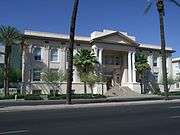 Domestic Arts building
Domestic Arts building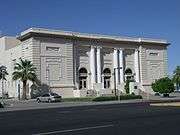 Auditorium
Auditorium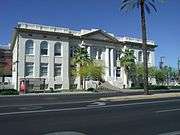 Science building
Science building
References
- Due to the presence of George Washington Carver High School, the school was segregated during a portion of its existence.
- "District Information / History". Phoenix Union High School District. Retrieved 2 December 2017.
- "Arizona High School Enrollment Figures (1912-2005)" (PDF). aiaonline.org.
- Ratner, Terry (4 June 2015). "Mystery of the 91-year-old Phoenix yearbook". The Arizona Republic. Retrieved 2 December 2017.
- "National Register Information System". National Register of Historic Places. National Park Service. March 13, 2009.
- Cindy L. Myers; James W. Garrison (April 1982). "National Register of Historic Places Inventory/Nomination: Phoenix Union High School Historic District / Phoenix Union High School". National Park Service. Retrieved April 5, 2018. With 21 photos, historic and from 1982.
- Fritcke, Katherine (29 December 2015). "'Fight On': Phoenix's First High School Creates Legacy Through Alumni Network". KJZZ-FM. Retrieved 2 December 2017.
- "Staff Report: Z-72-16-8" (PDF). City of Phoenix. 10 November 2016. Retrieved 2 December 2017.
- Goth, Brenna (25 January 2017). "Phoenix school that was segregated envisioned as 'a place you can talk the truth'". The Arizona Republic. Retrieved 2 December 2017.
- Finn, Elizabeth (July 1998). "The Struggle for Civil Rights in Arizona". State Bar of Arizona. Archived from the original on 4 March 2016. Retrieved 3 December 2017.
At mid-century, state law mandated segregation in the elementary schools but made it optional in the high schools.
- Arroyo Rodriguez, Nadine (18 October 2013). "Did You Know: George Washington Carver High School Has Rich History". KJZZ-FM. Retrieved 30 November 2017.
- "Frederick C. Struckmeyer". Arizona Legal Legacies Project. Retrieved 30 November 2017.
- Luckingham, Bradford (1989). Phoenix: The History of a Southwestern Metropolis. Tucson: The University of Arizona Press. p. 217.
- D'Andrea, Niki (6 October 2010). "Phoenix Union High School Memorabilia". Phoenix New Times. Retrieved 3 December 2017.
- "National Register of Historic Places Nomination Form for Phoenix Union High School Historic District" (PDF). National Park Service. 1982. Retrieved 3 December 2017.
- Schwartz, David (30 June 1996). "City ponders purchase of former PUHS site". Phoenix Business Journal. Retrieved 2 December 2017.
- "Powerhouse Coyotes were among nation's best". Arizona Daily Star. 3 July 2011. Retrieved 2 December 2017.
External links
| Wikimedia Commons has media related to Phoenix Union High School. |

